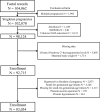Urinary 8-hydroxy-2'-deoxyguanosine levels and preterm births: a prospective cohort study from the Japan Environment and Children's Study
- PMID: 38316589
- PMCID: PMC10860051
- DOI: 10.1136/bmjopen-2022-063619
Urinary 8-hydroxy-2'-deoxyguanosine levels and preterm births: a prospective cohort study from the Japan Environment and Children's Study
Abstract
Objectives: To evaluate the association between urinary 8-hydroxy-2'-deoxyguanosine (U8-OHdG) level-a marker of oxidative stress-and the incidence of preterm births (PTBs).
Design: Prospective cohort study.
Setting: The Japan Environment and Children's Study (JECS).
Participants: Data from 92 715 women with singleton pregnancies at and after 22 weeks of gestation who were enrolled in the JECS, a nationwide birth cohort study, between 2011 and 2014 were analysed. U8-OHdG levels were assessed once in the second/third trimester using liquid chromatography-tandem mass spectrometry. Participants were categorised into the following three or five groups: low (<1.95 ng/mg urinary creatinine (Cre)), moderate (1.95-2.94 ng/mg Cre) and high (≥2.95 ng/mg Cre) U8-OHdG groups, or groups with <1.87, 1.87-2.20, 2.21-2.57, 2.58-3.11 and ≥3.12 ng/mg Cre. For stratification, participants with representative causes for artificial PTB were excluded.
Primary and secondary outcome measures: Adjusted OR (aOR) for PTB before 37 and 34 weeks of gestation were calculated using a multivariable logistic regression model while adjusting for confounding factors; the moderate or lowest U8-OHdG group was used as the reference, respectively.
Results: The aORs for PTB before 37 weeks of gestation in the high U8-OHdG group were 1.13 (95% CI 1.05 to 1.22) and 1.13 (95% CI 1.04 to 1.23) after stratification. The aOR for PTB before 37 weeks in the fourth group was 0.90 (95% CI 0.81 to 0.99). After stratification, the aORs for PTB before 37 and 34 weeks in the fifth group were 1.15 (95% CI 1.03 to 1.29) and 1.46 (95% CI 1.08 to 1.97), respectively.
Conclusions: High U8-OHdG levels were associated with increased PTB incidence, especially in participants without representative causes for artificial PTB. Our results can help identify the mechanisms leading to PTB, considering the variable aetiologies of this condition; further validation is needed to clarify clinical impacts.
Keywords: epidemiology; fetal medicine; maternal medicine.
© Author(s) (or their employer(s)) 2024. Re-use permitted under CC BY-NC. No commercial re-use. See rights and permissions. Published by BMJ.
Conflict of interest statement
Competing interests: None declared.
Figures
Similar articles
-
Urinary 8-hydroxy-2'-deoxyguanosine levels and small-for-gestational age infants: a prospective cohort study from the Japan Environment and Children's Study.BMJ Open. 2021 Dec 2;11(12):e054156. doi: 10.1136/bmjopen-2021-054156. BMJ Open. 2021. PMID: 34857577 Free PMC article.
-
Association of Maternal Asthma and Total Serum Immunoglobulin E levels with Obstetric Complications: The Japan Environment and Children's Study.Matern Child Health J. 2023 Jul;27(7):1229-1237. doi: 10.1007/s10995-023-03647-y. Epub 2023 May 2. Matern Child Health J. 2023. PMID: 37131017
-
Preterm Deliveries in Women with Uterine Myomas: The Japan Environment and Children's Study.Int J Environ Res Public Health. 2021 Feb 24;18(5):2246. doi: 10.3390/ijerph18052246. Int J Environ Res Public Health. 2021. PMID: 33668326 Free PMC article.
-
Impact of stage 1 hypertension in the first and second trimesters on adverse pregnancy outcomes: The Japan Environment and Children's study (JECS).Pregnancy Hypertens. 2022 Dec;30:232-237. doi: 10.1016/j.preghy.2022.11.002. Epub 2022 Nov 14. Pregnancy Hypertens. 2022. PMID: 36410284
-
Cervical pessary for preventing preterm birth in singleton pregnancies.Cochrane Database Syst Rev. 2022 Dec 1;12(12):CD014508. doi: 10.1002/14651858.CD014508. Cochrane Database Syst Rev. 2022. PMID: 36453699 Free PMC article. Review.
References
Publication types
MeSH terms
Substances
LinkOut - more resources
Full Text Sources

